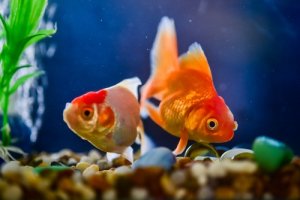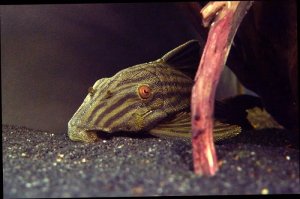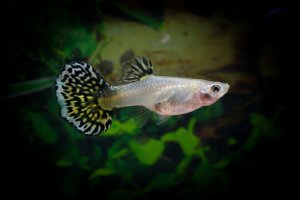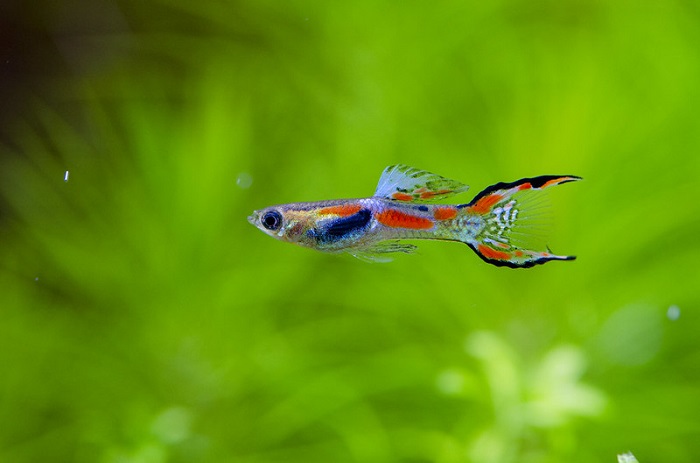
The Endler Guppy, also known as Poecilia Wingei, is a vivid-colored fish that comes from the Paria Peninsula in northern Venezuela. It is also known as Endler’s Livebearer. There are many reasons you might want to keep these stunning little fish. The distinctive colors and visual differences between males and females make them an attractive talking point for any tank.
These fish are rare in the wild and can sometimes be hard to find in pet shops. However, if you are lucky enough to encounter these unusual little fancy Guppy fish, this guide will show you exactly how to take care of them.
Breed Overview
| Origin | Northern Venezuela |
| Lifespan | 1-3 years |
| Size | Male 1 inch or 2-2.5 cm, female 2 inch or 4-5 cm |
| Colors | Males are vivid orange, greens, and blues, females are a duller, silver-bronze |
| Food | omnivorous |
| Tank Size | 5-10 gallons |
| Temperament | Peaceful |
| Water Temperature | 73-78 F (23-26 C) |
| Water pH | 6.5-8.5 |
| Water Type | Brackish water, salt water |
Appearance
The Endler Guppy is known for its distinctive color palette that includes metallic greens oranges, and bronzes in the males. The females are slightly duller colored, they can vary between a silver and bronze color.
What Is The Average Endler Guppy Size?
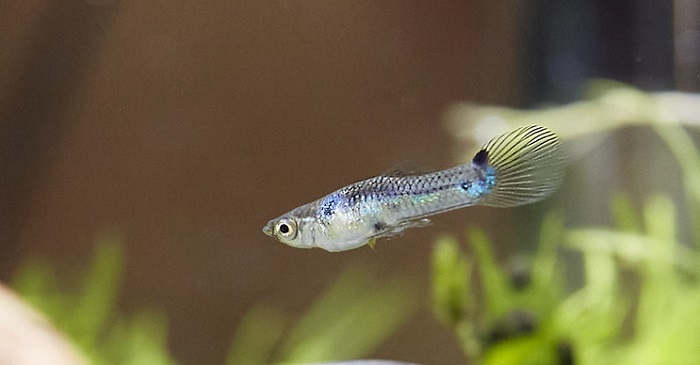
One unique thing about the Endler Guppy is that the males are smaller than the females. The females can reach 2 inches or 4-4.5 cm, whereas the males are very small, they are only 1 inch or 2 – 2.5 cm.
How Does The Endler Guppy Differ From Other Fancy Guppies?
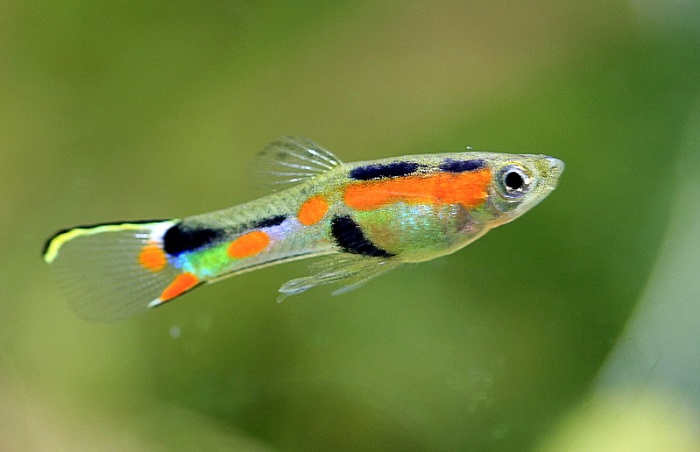
The common Guppy, or Poecilia Reticulata, may at first appear similar to the Endler’s Guppy, but they are very different species. The common Guppy comes from a similar Caribbean habitat but has been subject to much more selective breeding. As a result, there are many variations in terms of coloring, and most so-called fancy Guppies are actually found among these.
However, there is much more variation in the common Guppy color as a result. Endler Guppies, on the other hand, tend to follow the same color palette.
The tail shape of the common Guppy also tends to be fan-like, flowing behind them in the water. The tail of the Endler Guppy is more pointed and forked, giving them a nippy, streamlined appearance. As a result, compared to the Endler’s Guppy, the tails of the male common Guppy can sometimes slow them down.
Tank Setup And Maintenance For Fancy Guppies
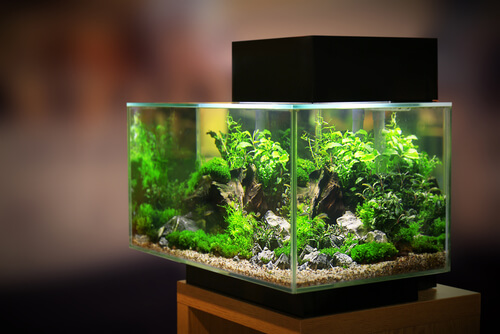
Size:
The absolute minimum tank size for a group of about 3-4 Endler Guppies is 5 gallons. As a result, these fish can be great if you want a small aquarium and don’t have much room.
However, like any fish, they will thrive if you give them more space. It also makes the tank less prone to algae overgrowth and increased toxicity in the water.
If you want a larger school, an extra 1-2 gallons per additional fish is advised.
Temperature, Salinity, And Filtration:
Overall, temperature requirements for the Endler Guppy are not that dissimilar from the other tropical fish they share a tank with. Anything from 73-78 F or 23-26 C can work. However, bear in mind the common Guppy can tolerate slightly higher temperatures. As will the passage on salinity below, remember that the common Guppy can adapt more easily to the Endler Guppy’s habitat than the other way around.
A well-planted tank can sometimes thrive without a filter, but it’s always good to include one just in case. This maintains water quality and prevents disease. A canister filter of 4x tank capacity is a good option for the Endler Guppy and many of its most common tankmates. Don’t go too strong – these fish are only small!
Author’s Note: These are freshwater fish, so don’t get them confused with the common Guppy, which can live well in either fresh or slightly brackish water. The Endler Guppy doesn’t come from these saltwater habitats!
Plants And Substrate:
A well-planted tank is a must, as it will help these little fish feel at home. You can mimic algae by floating plants such as Brazilian pennywort and duckweed on the surface of the tank, which also helps shade it from any lights you choose to install.
These fish can thrive with either a sandy or gravel substrate. However, some suitable tankmates, such as Cory Catfish, do better when they have a sandy as opposed to a gravelly bottom, as these tankmates are bottom dwellers and it is less sensitive on their stomachs.
Other suitable aquarium plants include:
- Guppy grass
- Java fern
- Marimo moss balls
- Water lettuce
- Dwarf hairgrass
- Anubias
Best Tankmates For Endler Guppies
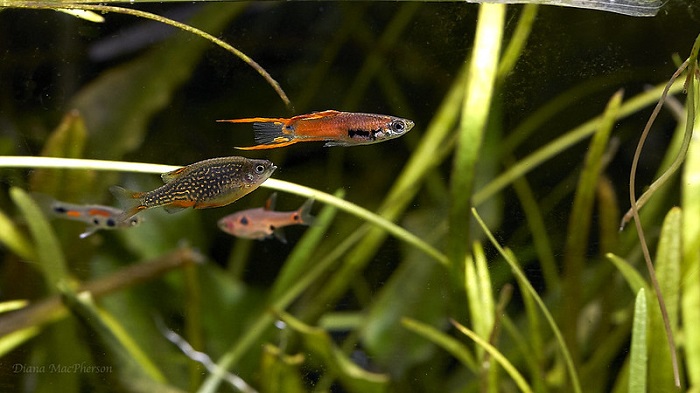
Endler Guppy tankmates are generally any small fish that will keep themselves apart from your Guppies, such as tetras, rasboras, and bottom dwellers such as cory catfish, kuhli loaches, and other small catfish. As a rule, tankmates for the Endler Guppy are the same as tankmates for the common Guppy.
Endler Guppies can also coexist with the common Guppy. However, be aware that these two species also interbreed and can create hybrids.
Some other great tankmates include:
- Platies
- Mollies
- Bristlenose pleco (in larger tanks)
- Cherry shrimp
- Nerite snails
- Swordtails
Male And Female Guppy Ratio
Some aquarists recommend one male for every two or three Endler Guppy females. Why is this? Simply, it is because Guppies are prolific breeders. The males will attempt to mate with the females, and the females will, unfortunately, have no time alone! Creating an uneven sex ratio prevents this.
Feeding Endler Guppies
Your Endler Guppies are very small fish, so it is important to take this into account when you feed them.
Endler Guppies will not be able to eat huge amounts of food, so start with a very small pinch of tropical fish-formulated flakes and see how much they can eat. If they still seem hungry, offer them a little bit more, but only feed as much as fish can eat within 5 minutes.
Behavior And Temperament
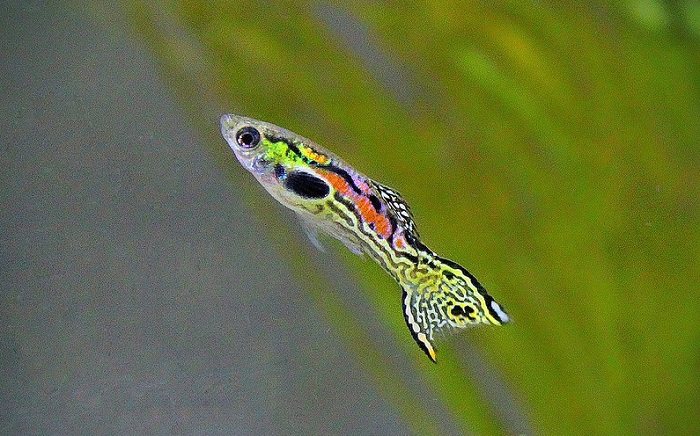
Endler Guppies are generally peaceful fish. They are schooling fish, and it can be delightful to watch clusters of them together, as their shimmering colors really add something special to the tank.
However, one thing to bear in mind is they are prolific breeders and can be aggressive to the opposite sex. This is especially the case with males towards females, as they will try to mate with them.
Common Diseases And Complications
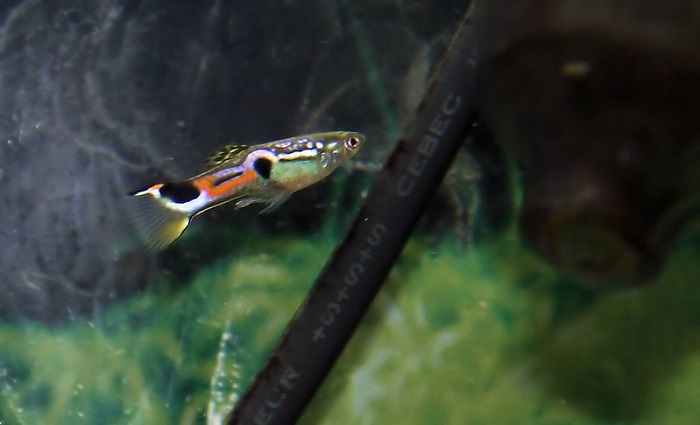
Endler Guppies are subject to many of the same stresses as other freshwater tropical fish. For all these diseases, a warning sign can be your Guppy not eating, or being lethargic. These include the following:
- Ich
Ich is a parasitic infection that causes white spots all over your fish’s body. Luckily, you will easily notice it, due to the bright colors of your Endler’s livebearer. It is treatable with over-the-counter medication but put the fish in a separate tank to do so.
- Fin Rot
Fin rot is bacterial in nature, and generally caused by poor water conditions, which in turn stem from overcrowding. It manifests as sort, red edges on your fish’s delicate fins. Due to their small size, it can be very painful for them. Therefore, you can prevent it with a bigger tank. Like ich, treatment is with quarantine and an antibacterial medicine.
- Swim Bladder Disease
Swim bladder disease is generally also bacterial and has similar causes to fin rot. Therefore, you should treat it in a similar manner. But how to spot this disease? Your fish will invariably start swimming in an unusual manner. This can include resting on the bottom of the tank, rolling from side to side, and struggling to maintain position in the water.
The only thing that can look similar is pregnancy in females. To rule this out, check for the gravid spot, as outlined in the ‘breeding section’ below. However, in males, this disease is pretty unmistakable.
- Velvet
Velvet is another parasitic infection and is thus treatable in a similar manner to ich. However, it looks very different. Also known as gold dust disease, it manifests as small gold flecks over your fish’s body. Because of your Endler’s metallic coloring, this can make it hard to spot. However, pay close attention to changes in behavior, such as lethargy.
Size And Filtration Issues
Apart from common diseases, one thing to note is that because these fish are really small if you have an uncovered filter, they can get sucked into it. This generally applies to any small aquarium fish, but as they are some of the smallest, the Endler Guppy can be more susceptible.
Author’s Note: These guys are fast swimming, but better safe than sorry. As a result, ensure you cover the filter. A sponge filter is a good choice as a result, because of its soft nature and the fact it is covered. This means your fish won’t injure themselves on it.
Breeding
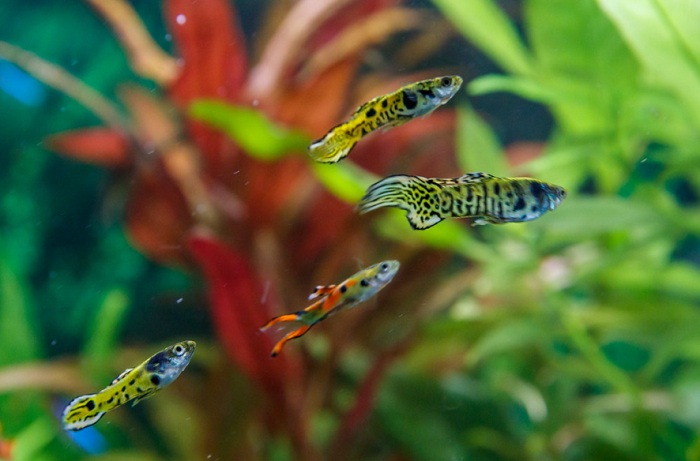
The name ‘Endler’s Livebearer’ might give you a hint about the mating habits of these fish! Indeed, these Guppies actually give birth to live young. So, how do Guppies mate? And how do you go about breeding your Endler Guppies?
The truth is, it’s not too difficult. These fish breed easily. Even keeping a few of each sex in the same tank may often result in young.
However, there is a benefit to using a separate breeding tank. Once the female is pregnant, you can remove the male. This means the female has peace and quiet, as otherwise, the male will attempt to mate with her again whilst she is pregnant.
You do not need to do much to encourage mating. Instead, simply put the males and females together in the same tank you will observe the following steps:
- The male will either court or sneak up on the female.
- The female will display her willingness to mate by waving her fins.
- The male impregnates the female with a specialized anal fin called a gonopodium.
- After mating takes place, the female will become pregnant.
Often with Guppies, mating is a blink-and-you’ll-miss-it affair. The Endler Guppy is no different. You may assume mating is normal rough and tumble behavior in a community tank, and as a result, become surprised when your female Endler Guppies become pregnant. This is another good reason to only keep males, or even reduce the ratio of males to females.
How Do I Know If My Endler Guppy Female Is Pregnant?
One of the biggest ways of telling pregnancy in a female Endler Guppy is that the gravid spot will change color. This is a dark spot on your female Endler’s body that will get darker as the pregnancy progresses. Located near the anal fin, it will be dark brown to black when she is in the mid to late stages of pregnancy.
How Do These Guppies Give Birth?
The Endler Guppy gestates for roughly one month, though this can be as short as 20 days. As the pregnancy progresses, you may notice a long filament growing down from your fish from near the anal fin. This is part of the uterus that extends outside the body and protects the young as the female gives birth to them. A female Endler Guppy can give birth to 20-30 young, and the labor process can take over 12 hours!
Helping Your Female Give Birth
Due to how prolifically these Guppies breed, you don’t need to be very hands-on in helping them mate. However, you may need to be careful as your female is giving birth. When she shows signs of going into labor, if she is not already in a separate tank, it can help to put her in a breeding box. This prevents male Guppies and other fish from harassing her.
It’s also good to check occasionally as not only can Endler Guppies develop complications during the delivery process, they will be very tired afterward. In this case, it helps to give them a nutrient-dense snack such as brine shrimps or bloodworms.
Author’s Note: Guppies of all kinds are also prone to eating their young. Therefore, as soon as it looks like she has recovered, it is a good idea to remove the adult female from the breeding tank so the fry has a chance to survive. Once the fry is large enough, you can feed them on infusoria or baby brine shrimps.
Bottom Line
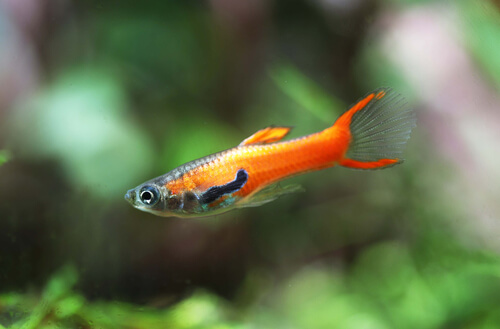
If you’re looking for a striking alternative to the common Guppy, the Endler Guppy is a great choice. In fact, one part of their appeal is they are simpler and more striking in their color, so they work in minimalist aquariums, yet are colorful enough that kids and adults, experts, and non-experts all can enjoy the presence of these little fish.
Either way, these are a rare but hardy species of Guppy that deserves more attention and is really special if you manage to find them for your tank.


